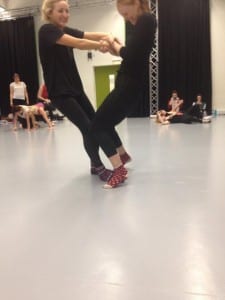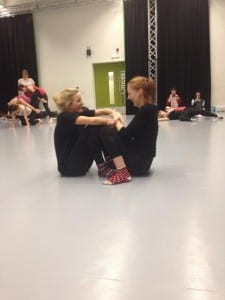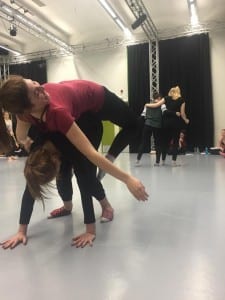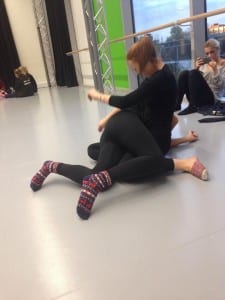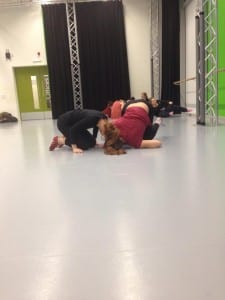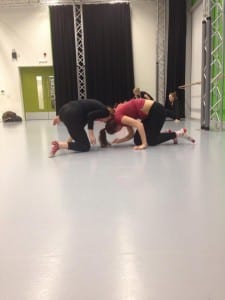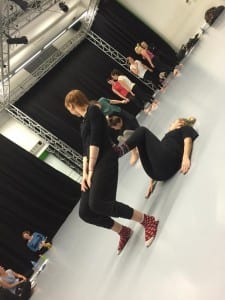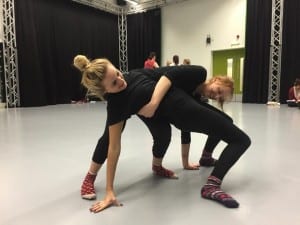After focusing on pushing, pulling and folding around the space, we began to experiment with the affects of spirals in partners, in which both of us were constantly spiralling around one another. When spiralling, the tone of my movement dramatically increased as my action became dynamically chaotic, faster-paced and energetic, which completely contrasts against the sustained and controlled quality my movement retained from previous weeks. The idea of constantly spiralling whilst always remaining in contact completely removed my movement from anything habitual, especially when the pace quickened as we both fought to become the under or over dancer. As our movement was constant, there was also a continuous weight exchange between the two of us, allowing us to really listen to one another, release control and shift through the space with ease and fluidity. Continuing on from our research lab last week, spiralling created various ways to not only travel around the space but also through levels quickly and unhabitually, which is something I hope to use in our score.
However the majority of the lesson focused on developing our scores for the open studio on Thursday, modifying our rules only slightly from the previous week before we performed in front of the other group. The set of rules are score followed included:
- To start, each dancer asks an audience member to pick a number between 1 – 10. This number relates to the number of people you must dance with before leaving the space and whether you start on the floor, if its an even number, or on a higher level, if an odd number.
- You can only enter the space after seeing 3 lifts performed
- Whenever transitioning between levels you have to find the most complicated route
- If a duet is left in the space, the others must create a corridor for them to travel down – this can only end after the duet complete 3 lifts
- To end, each dancer must move to sit in the audience leaving either a soloist or a duet in the space, who must decide on an ending position coherently
After performing our score the first time, we were given feedback in order to modify or keep in mind certain aspects of the score before we performed it once more. Overall the audience stated that the idea of chance was both visually and mentally interesting, as many tried to guess the relevance of the numbers. However it was noted that we could have utilised the space more, as most of the action happened upstage away from the audience and therefore as a group we need to be spatially aware when improvising to ensure the entire space is filled. Also when the corridor is created, the two dancers should not rush to perform three lifts but instead enjoy the improvisation, allowing the audience to really engage in the movement happening before other dancers join in. Additionally we need to be careful when trios are created as often one person becomes the under dance taking the weight from the other two dancers instead of creating a constant shift between all three. It is also important to know your role within the trio, in which the third dance does not need to completely take or give her weight onto the other two dancers but instead could simply offer more surfaces or support that might or might not be taken, depending on where the duet takes them.
Performing the score for the second time before the open studio, there was a moment when a duet was performing in the space and before the other dancers could create a corridor coherently, the two dancers had already dispersed, which left some members of the groups confused to carry on or return to the side of the space. Taking this into consideration we decided as a group to be really clear in your conviction to whether or not you are entering the space as well as pay attention to when a corridor is being created.
Open Studio Performance
To start the performance, we participated in a normal jam session as the audience members entered the space. We then started the score as soon as the audience were seated and settled in which all members of the group approached the audience separately and at different times to ask them to pick a number between 1 and 10. Both during the performance and practice, I was given a higher number, which not only meant I was constantly moving in the space, only stepping out and observing once or twice, but also it allowed me to quickly travel between duets, getting the chance to dance with the majority of the group. I also found that performing to an audience, I was able to push the boundaries a lot more and at one point Robyn and I sat in the audience as there was a spare seat before continuing our duet, which was exciting and different to anything we have done in class. Personally I also think I utilised the space a lot more, travelling from upstage to downstage constantly. However as our score primarily surrounded chance, there were not as many chances to create a corridor for the duet in the space, as there were always either three or four people in the space at any one time. If we were to perform the score again, I think we would change the rule involving the corridor to include trios or even if there was a duet and solo in the space so that there were more opportunities to change the dynamics of the space. Overall I enjoyed performing the score and found that I not only shifted between levels with ease but also had the opportunity to give and take the weight of dancers I previously have not improvised with.
